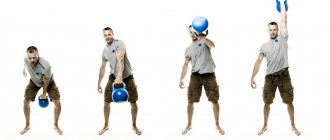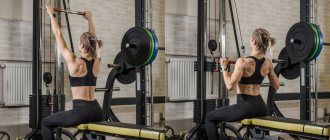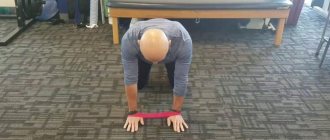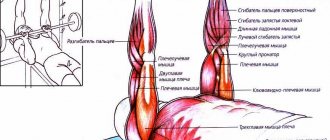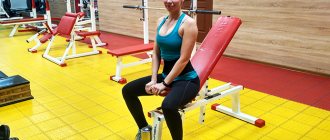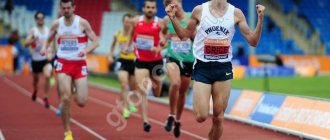There is very little information on powerlifting training on the Internet. Everything that is there is designed for athletes with extensive theoretical training, who understand weightlifting terms and know how to correctly describe cycles.
In this article, we'll look at what powerlifting accessory exercises and whether they should be included in your training program.
Attention! Before you start studying the exercises, understand their classification. Be able to distinguish between general preparatory and special preparatory.
Classification of exercises in powerlifting
Classification of exercises in powerlifting (Boris Sheiko model)
Powerlifting exercises are divided into two groups:
- Basic: competitive and special-preparatory. They are the foundation of your training.
- Additional: general training - improves the physical qualities of the athlete. Exercises for individual muscle groups with various apparatus (horizontal bar, parallel bars). This also includes running, swimming and sports games. They indirectly influence the results in competitive exercises and serve to diversify the training process.
Basic exercises are divided into two subgroups:
| Classification of basic exercises in powerlifting | ||
| Competitive | Directly squats with a barbell, bench press and deadlift. | |
| Special preparatory | Improves the technique and physical qualities of an athlete in competitive movements. | |
Basic exercises are used to create the “foundation” of an athlete. And additional ones are for comprehensive development.
General preparatory and special preparatory exercises are usually called auxiliary (auxiliary).
Auxiliary exercises in the bench press training system are a rather controversial issue. Indeed, some coaches consider their presence in the complex to be unjustified, believing that the bench press is a relatively simple movement from a technical point of view that can be trained simply on its own. However, the phase separation of the bench press involves certain areas of movement. In addition, the dead point (BCP) in the bench press does not lie in one area. The position of the MT differs not only among different athletes, but can also change for an individual during the preparation process. This necessitates inclusion in a set of exercises aimed at leveling out weaknesses in movement, as well as developing special qualities in athletes. Individual exercises can be used to improve technique, increase power and speed of movement. For ease of classification and ease of use, auxiliary exercises for the bench press can be combined into groups.
According to the training effect :
- Special auxiliary exercises. These are exercises that have a special training effect that allows you to improve specific movement characteristics;
- General developmental auxiliary exercises. These exercises are not directly related to the bench press, but their effect on certain muscle groups can increase their tone and improve the athlete’s fitness.
In accordance with the phase division of the bench press:
- Exercises for breaking off the chest and accelerating the barbell;
- Exercises for the middle section of the amplitude;
- Pressing exercises;
- Exercises to improve stabilization and negative phase.
As a rule, the bench press itself is performed during the training of athletes in a style that differs from the competitive one. It differs primarily in that it lacks the necessary stop on the chest. This is due to the fact that it is difficult for an athlete to hold a pause in presses for a large number of repetitions - the ligaments of the chest and arms receive additional stress.
We will analyze the auxiliary exercises in accordance with the phase division of the bench press, highlighting special and general developmental exercises, respectively.
Exercises for breaking off the chest and accelerating the barbell.
A powerful lift of the barbell from the chest is the key to a successful start to the movement. When an athlete performs a stall with confidence, it allows them to develop speed at the bottom and thus improve their overall power and speed. In addition, the high degree of acceleration of the bar makes it possible to overcome the dead point immediately, without spending a lot of energy to overcome it. The effectiveness of an athlete's stall largely depends on his technical skills, primarily on how effectively the athlete incorporates his legs into the movement. It is also important not to sink the barbell into your chest while holding the pause. Accordingly, as the athlete’s technical skills increase, the lifting of the barbell from the chest also improves. However, it may be necessary to include additional exercises that will improve this phase of the bench press.
Special exercises
The paused bench press in a competitive manner is one of the main exercises in the strength complex. It is designed to develop competitive movement. Due to the fact that athletes in training, as a rule, perform the bench press without a pause, this exercise is aimed primarily at working out the stall and acceleration of the barbell;
Bench press with a long pause (2.3 seconds) puts the emphasis on the breakdown even more. The main advantage of this exercise is that it allows you to practice the skill of holding a barbell on your chest motionless for a long time;
The bench press in a power rack with low supports allows the athlete to specifically work out the stall during the bench press. In this exercise, as in any other exercise in the power rack, the athlete’s ligaments receive additional load;
speed bench press with chains or bands However, this exercise also allows you to practice breaking the barbell and additionally receive a load in the required phase;
The incline press places the load on the front deltoids and upper chest. It is the deltoid muscles that bear a significant load during the fall, so this exercise can also be used to level the initial phase of the bench press.
General developmental exercises
General developmental exercises for getting off the chest can include exercises for the anterior deltas.
Raising a dumbbell in front of you makes it possible to increase the tone of the anterior deltas, which experience significant stress when the barbell is torn from the chest in the bench press;
Chest pressing while sitting or standing with a different grip also helps to increase the tone of the deltoid muscles, but this exercise should be included in the complex carefully. The fact is that it indirectly engages the triceps, which is also involved in other auxiliary exercises. Because of this, it is better to use other auxiliary exercises designed to level out the stalling phase, however, beginners who need to increase shoulder muscle mass can also use the standing (sitting) chest press.
Exercises for the middle phase of the press
Having achieved a breakdown, the athlete goes through the middle phase of the bench press , which can be considered the most problematic. About 70% of all athletes experience problems in this phase of the bench press. When passing the midpoint of the amplitude, the load on the athlete's pectoral muscles, as well as on the triceps, increases significantly.
Special exercises
Pressing from a bar of 3, 5, 8 cm makes it possible to focus on the phase in which the athlete has problems. If, even when using moderate weights, the movement noticeably loses power and speed at the midpoint of the amplitude, then pressing from the problem area can become the main exercise of the complex. This shift in priorities makes it possible to quickly correct the existing flaw in the movement;
high-speed kick press A powerful skill is developed, speed develops, which increases the consistency of the movement, and also allows the athlete to more smoothly and powerfully pass the dead point in the middle phase or even in the push-up phase;
The medium grip bench press allows you to shift the load to the triceps. The degree of grip narrowing determines how much priority the triceps are worked, compared to the pectoral muscles. This exercise can be used when an athlete has not only problems at the midpoint of the amplitude, but also in the push-up phase;
A bench press is a bench press with pauses during the positive phase of the movement. By adding static elements, the load on the athlete's ligaments greatly increases, which makes it possible to strengthen the middle section of the amplitude, as well as add power to the movement.
General developmental exercises
The main general developmental exercises for the middle phase of movement in the bench press can include all kinds of exercises for the chest muscles. It is the chest that is the main mover during the passage of the middle phase of the amplitude.
The dumbbell fly press is one of the most effective general developmental exercises. Its implementation should resemble a competitive bench press as closely as possible - the correct fulcrum points must be maintained, as well as the retraction of the shoulder blades. Rotating the hands in the direction of movement allows you to additionally load the stabilizer muscles. The angle at the elbows is small: from 45 to 90 degrees.
High-speed push-ups with fixation on the platform make it possible to develop speed and power of movement. In addition, by performing this exercise, athletes learn to perform the bench press dynamically, at high speed. The exercise will be effective not only as an auxiliary exercise designed to improve the passage of the middle phase of the bench press, but also for a general increase in power and speed of movement.
Exercises for the pectoral muscles in simulators can increase the tone of the pectoral muscles; accordingly, it may be necessary to include them in the complex if the bencher’s chest lags behind in development;
Dips are the least effective exercise in the bench press routine. Like the standing (seated) press, it is relevant for beginners whose goal is to gain muscle mass or simply comprehensively develop strength qualities.
It should be noted that the load on the chest of a bench press is quite large, so the described auxiliary exercises should be included in the complex carefully so as not to lead the athlete to overtraining. In addition, it is strictly not recommended to perform the classic fly when the angle at the elbows is quite large (more than 100 degrees), since the biomechanics of this exercise contributes to the formation of significant damage to the pectoral ligaments, which can subsequently lead to a tear in the pectoral muscles or even more significant injury.
Push-up exercises
Having passed the midpoint of the amplitude, the athlete can only press the barbell and fix the projectile in the final position. The load in this phase falls primarily on the triceps.
Special exercises
Pressing from a bar of 10, 13 cm makes it possible to accurately level the athlete’s pressure;
Pressure in the power frame , when the stops are set to the upper position for pressure, also helps to improve this phase;
Pressing with chains or bands also helps to engage the triceps more. This type of bench press can be used as the main one if the athlete experiences significant difficulties when performing a push-up in the final position;
The close grip bench press characterizes the strong involvement of the triceps in the work. In this exercise, you should try to keep your elbows parallel to the plane of the body, without spreading them apart under tension.
General developmental exercises
Cable extensions are an isolating exercise for the triceps from the arsenal of bodybuilders. This exercise makes it possible not only to increase the tone of the triceps brachii muscle, but also allows you to pump up your elbows, which makes it possible to promptly prevent injuries, as well as eliminate them.
In addition to cable extensions, it is advisable to include other exercises for the triceps in the complex: French presses and so on. Since the triceps is the main mover in the bench press, you should constantly include in the complex various exercises aimed at increasing the strength of these muscles.
Stabilization in the bench press, as well as the effectiveness of passing the negative phase, directly depends on the development of antagonist muscles: the latissimus dorsi, as well as the biceps brachii muscle. If an athlete has difficulty controlling the amplitude on the bench press or has problems lowering the apparatus to the chest, then it is advisable to perform various general development exercises for these muscles. This includes pull-ups, various rows for the latissimus dorsi, as well as exercises for the biceps: standing barbell curls, dumbbell curls, and others.
In addition, proper bench press technique involves actively engaging your legs in the movement. It is for this reason that the complex may include squats with a barbell on the shoulders or other variations of this exercise.
How to choose auxiliary exercises?
Special preparatory exercises are selected individually, based on the athlete’s weaknesses and depend on the training period. However, novice athletes do not know their weaknesses in competitive exercises, so 2-3 general preparatory exercises can be included in the training.
We have prepared special materials that contain a list of special preparatory exercises for bench presses, squats and deadlifts:
Access is temporarily closed. Contact the site administration.
Bench Press Assistance Exercises Squat Assistance Exercises Deadlift Assistance Exercises
Phases of performing the bench press exercise
First phase . The pre-start position technique consists of: a) the athlete’s position on the bench (back arch, leg placement); When positioned on a bench, the athlete should try to arch his back as much as possible, keeping his shoulders and buttocks in contact with the bench. Since January 2001, technical rules have allowed lifting your head off the bench.
The more the athlete arches his back, the shorter the distance of the barbell, and therefore the less physical effort. Moreover, the height of the bridge can be limited only by the flexibility in the lumbar and thoracic regions of the athlete’s body, since the height of the bridge is not limited by the competition rules. At the same time, you should try to pull your shoulders as close to the pelvis as possible.
The athlete’s first point of support in this position is the neck and trapezius, the shoulder blades should be brought together and should not touch the bench, the shoulders should be lowered as far as possible. The muscles of the legs and back are in a tense state, the pelvis should touch the bench, but not lean on it. The second fulcrum is the athlete’s legs.
At the moment, it is very important at what height the barbell is located. It should lie on the racks at a height at which the athlete can accept the barbell from an assistant without breaking the bridge. If the barbell rests high on the racks, the athlete will have to reach for it and the arch in his lower back will decrease, which will increase the length of the press. If the barbell is in a low position on the racks, the athlete will not be able to bend to its full extent and will have difficulty removing the barbell from the racks. b) grip of the barbell; The fingers should clasp the bar lying on the racks. In this case, the thumbs are located “locked” around the fingerboard.
Basically, powerlifters use 2 grips:
- wide (81 cm), the maximum allowed by the competition rules, in which the main load falls on the pectoral muscles
- medium grip (70-75 cm wide), which more strongly engages the triceps and deltoid muscles, depending on the length of the arms and the strength potential of the athlete’s pectoral muscles.
Because all athletes have different body structures, limb lengths, and strength areas, the ideal grip width may be different for everyone. But nevertheless, the axiom is the same for everyone: the wider the grip of the hands (but not more than 81 cm), the shorter the path of movement of the barbell from the chest and, as a result, the physical work performed by the athlete will be less. And vice versa, the narrower the grip of the hands, the longer the path of movement of the barbell, and the physical work performed will be greater.
We also must not forget that the wider the grip of the hands, the greater the load placed on the pectoral muscles, and the narrower the grip, the more the triceps and deltoid muscles are loaded. The anterior lobe of the deltoid muscles should be below the line of the pectoral muscles.
c) removing the bar from the racks. The lifting of the barbell is carried out by the athlete independently or with the help of assistants. Recently, at all international competitions, one assistant in the center helps remove the barbell. Receiving the barbell from the assistant from the racks, the athlete slightly raises the pelvis, brings the barbell forward and lowers it as far as possible with straight arms, by bringing the shoulder blades together and lowering the shoulders down, then lowers the pelvis until it touches the bench.
d) position of the legs. The feet should be placed as close as possible to the vertical projection of the pelvic girdle. The leg muscles are in a tense state. The athlete must stand on his feet and only touch the bench with his buttocks. This practice helps stabilize the entire body, and the muscles involved in the exercise work more efficiently. Wide-legged positions are just as common as close-legged positions, but both positions involve elements of “closing” the body on the bench.
Second phase . Starting position. After receiving the barbell from the assistant, the athlete fixes the barbell in a stationary state with his arms fully straightened at the elbow joints and waits for the senior judge’s “start” signal.
Third phase . Lowering the barbell to the chest. After the senior judge’s signal, the athlete lowers the barbell to his chest. Lowering the barbell to the lower edge of the pectoral muscles should be carried out relatively slowly, with full control of the tension of all muscle groups involved in the movement. In this case, the athlete makes a counter movement with his chest towards the bar, without lifting the support points of the body from the bench. The angle between the shoulder and torso is approximately 45 degrees both when lowering the barbell and when pressing it from the chest. Lowering the barbell to the chest and pressing from the chest is performed while holding your breath.
Fourth phase . Fixing a pause with a barbell on the chest. After receiving the signal from the senior judge, the athlete must lower the barbell to his chest and hold it in a stationary position on his chest with a certain and visible pause. Standing still means stopping.
Fifth phase . Barbell bench press. a) tearing the barbell off the chest; After the barbell has visibly stopped on the chest, the athlete puts maximum effort into the muscles that directly perform the press - the pectoralis major, deltoids, triceps and lats.
With the so-called “chest” style of pressing, the shoulders of the arms should be perpendicular to the body, while getting maximum benefit from the inclusion of the anterior deltoid muscles in the work. When performing a triceps press, the elbows should be moved slightly closer to the body.
The initial impulse to tear the barbell from the chest is also given by the latissimus dorsi muscles, moving the athlete’s shoulder joints forward. With the “chest” style, the bar moves almost vertically with a slight deviation towards the racks; with the “triceps” style, it moves backwards from the vertical plan. A powerful exhalation is made in the upper third of the press, almost when pressing with straight arms.
Some athletes, when lowering the barbell to their chest, tense their pectoral muscles and relax their arm muscles a little. They explain that this is necessary to ensure a sharp release from the chest, a small acceleration, which is achieved by relaxing and then sharply tensing the latissimus dorsi muscles, immediately engaging the pectoral muscles, deltoids and triceps. Other athletes, when placing the barbell on their chest, do not relax their arm muscles, so they cannot suddenly pull the barbell off their chest.
When an athlete lifts the barbell from his chest, the movement at this moment should go from the legs (by tensing them) towards the head, but in no case upward, otherwise the pelvis will be separated from the bench.
The bar should move approximately vertically upward, with a slight slope towards the racks. We must try to ensure that the bar does not move strictly vertically upward or towards the legs, this excludes the deltas from working.
b) passing the “dead point”; The height and time of manifestation of the “dead spot” are purely individual for each athlete. Their values depend on the qualifications of the athlete, gender, and the percentage of the weight of the equipment to the individual maximum result in the bench press. It has been established that with increasing qualifications of athletes, in competitive conditions, a more pronounced “dead point” is observed. This fact is probably due to the weight of the projectile approaching the record result of a certain athlete.
The time for the manifestation of this zone from the GP between the 4th and 5th phases is on average 0.4 - 1.2 s. Depending on the anthropometric characteristics of the lifter, the distance from the chest at this time is 11–18 cm.
c) we'll push it. During the final part of the press, (approximately in the upper third of the press), it is recommended to exhale powerfully and sharply. Straightening your arms at the elbows should occur simultaneously.
Sixth phase . Fixing the bar in the final position with straight arms, until the senior judge’s command “on the racks” - (“rack”). After full and simultaneous straightening of the arms, the athlete fixes the barbell in a stationary position and waits for the senior judge’s signal to “rack”.
Seventh phase . Returning the barbell to the racks (after the senior judge’s command “rack”). After the senior judge’s signal, the athlete returns the barbell to the racks independently or with the help of assistants by shifting the center of gravity of the projectile, located in the straightened arms, back, for the vertical projection of the athlete's eyes.
Do you need to do assistance exercises?
Do you need to do assistance exercises?
If you are an athlete and know your weaknesses in competitive exercises, then perform special preparatory exercises according to our recommendations in the last section.
For general development, beginners can perform general preparatory exercises at the end of the workout. For example, bent over rows, standing dumbbell presses, lunges. All these exercises will help diversify your workout and increase muscle tone.
Basic mistakes in auxiliary exercises
Mistake 1 - a large number of auxiliary exercises
Perform at least 6 accessory exercises on different muscle groups to work your entire body.
There should be no more than 3 auxiliary exercises per workout, since your main goal is progress in competitive exercises.
Mistake 2 - striving for maximum progress in general preparatory exercises
Try to increase the working weight from workout to workout.
Perform general preparatory exercises with a standard load: 3 sets of 8-12 repetitions. And gradually increase the weight, but don’t try to do it every workout. Your main task is to progress in competition.
Mistake 3: Doing auxiliary exercises to failure
At each workout, complete the auxiliary requirement.
It happens that after a high-volume workout (many sets and repetitions), there is no strength left to perform auxiliary exercises. This is a completely normal situation, so if you feel tired, do not perform accessory exercises or reduce the working weight in them by half.
Choosing exercises in bodybuilding[edit | edit code]
Read the main article:
How to create a training program
This article is based on the recommendations of Christian Thibadeau, a long-time weightlifter and specialist in developing training programs.
The exercises are divided into 4 categories. Choose from them according to the purpose of your program.
- Main exercises:
This category includes “big” exercises with free weights, working several muscle groups and joints, preferably in several planes. They allow you to use maximum weight for the target muscle group and place the most stress on both the body and the nervous system. - Additional exercises:
The same as the main ones, but with less stress on the body and central nervous system. - Auxiliary:
This group includes a large number of different isolation exercises and most exercises on machines. Due to the ease of movement and weight loss, the nervous system is less stressed. - Corrective Exercises:
These are exercises to correct imbalances in muscle development or tighten weak areas. For example, exercises for the rotator cuff fall into this group.
As a rule, in bodybuilding, one muscle group is performed with: 1 main exercise and 2-3 additional or auxiliary exercises.
Auxiliary exercises using the example of the Russian cycle
We advise beginners to study according to the Russian cycle. This is a simple training program that automatically calculates the working weights, approaches and repetitions.
Article about the Russian cycle
Is it necessary to perform auxiliary exercises in the Russian cycle? General preparatory ones are optional, but you can add them for variety. If you have weaknesses in the exercises, follow our recommendations.
At weeks 4-9 of the cycle, you need to reduce the working weight in the auxiliary exercises in order to concentrate on increasing the results in the competition ones.
AUXILIARY AND SPECIAL EXERCISES
Auxiliary exercises of the first and second lines of training include:
- leg presses;
- isolated exercises for the muscles of the lower extremities (extension and flexion of the legs, hyperextension);
- exercises for the lower leg muscles;
- special exercises (deadlifts from the floor, swings with weights).
Within the framework of this work, I will not describe exercises of a local impact for the gluteal and adductor muscles of the lower limb. When training relatively healthy people, these muscle groups receive enough load in essential exercises and leg presses, and during rehabilitation they are selected and assigned individually.
Leg presses
The exercise is performed in a special simulator. As a rule, the press is performed in a sitting position (legs straightened parallel to the floor) or lying down at an angle of 45°.
Presses are performed with one or two legs.
Phase 1. starting position
Double leg press. The legs are placed on the platform of the simulator in a position that is convenient in width and height. The feet should be placed no narrower than the width of the pelvis, but standing much wider than the shoulders is also undesirable. The turn of the toes depends on the width of the feet - the wider the set, the greater the turn. The position of the back requires special attention: a neutral position of the spine is of fundamental importance in this exercise, no less than in squats and deadlifts.
Single leg press. Both legs are placed on the platform at pelvic width, after which one leg is moved down (placed on the floor). The remaining conditions are similar to the two-leg press.
To perform presses, you must straighten your legs (legs) and remove the platform movement restrictions. In most cases
It is necessary to fully straighten your legs only at the beginning and end of the exercise approach in order to return the platform to the stops.
Phase 2. Eccentric contraction
With a smooth, uniform movement, the legs (legs) bend at the hip and knee joints, and extend at the ankle joints (depending on the execution option). Regardless of the width of the feet, the direction of movement of the knee joint should coincide with the long axis of the foot: the center of the knee joint moves in the direction of the second toe. At the same time, an inhalation is made.
See also: Gym at home
Phase 3. End position
The movement ends when the knee joints flex >90°. The “depth” of flexion is determined by the ability to maintain lumbar lordosis, which, along with slowing down the movement, ensures the safe performance of the exercise. When learning the exercise, as well as to increase the load on the thigh muscles, it is recommended to stop for 1-2 seconds before changing the direction of movement.
Phase 4. Concentric contraction
Using a smooth, uniform movement, straighten your legs at the knee joints to a flexion angle of 10 - 30°. At the same time, you exhale.
The most common errors when performing
- violation of the neutral position of the spine;
- bringing your knees together or apart when moving;
- too narrow (narrower than the width of the pelvis) or excessively wide (much wider than the shoulders) placement of the feet;
- relaxation of the abdominal muscles;
- sudden, uncontrolled movements;
- holding your breath.
Authors: Jim Stoppani, Dmitry Sillov
Similar articles
- Full and distributed squats
- Work of muscle groups during leg presses
- SINGLE LEG SQUATS

